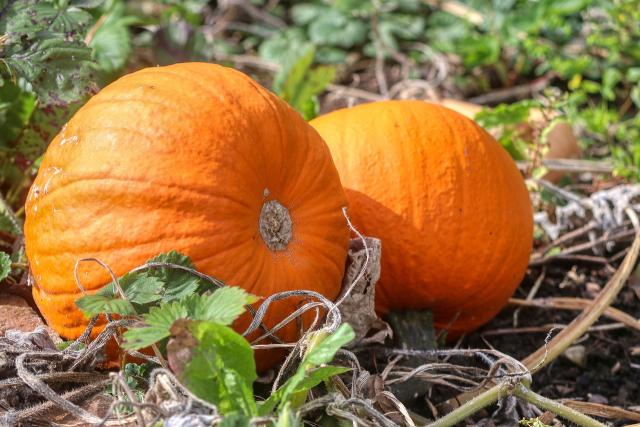Spooky Sustainability - Pumpkin Practices

As Halloween draws near, it’s time to start figuring out decorations for the house, apartment, or even dorm. Pumpkins and Jack-o-Lanterns are a staple of the Halloween decoration market. However, these iconic carved gourds eventually rot, and every year after Halloween around 1.3 billion pounds of pumpkin end up in landfills around the United States. So how can we get our spooky decorations to last longer and turn this environmental trick into a treat for the planet?
Choosing a Pumpkin
Turning Halloween green starts before even taking the pumpkin home. Going to a local supermarket and picking a pumpkin from the seasonal cardboard boxes that appear every October may be convenient, but is likely your least environmentally friendly option. Unless specifically labeled, those pumpkins potentially traveled hundreds of miles from farms across the nation. This long-distance travel produces greenhouse gasses that contribute to global warming. If you are going to get your pumpkin from the local grocery store, look for ones labeled as having been grown by local farmers, or that were grown organically.
Another alternative is to head to the local pumpkin patch or farmer’s market! Farmer’s markets showcase local produce and products, meaning you’re more likely to find a local pumpkin at this market There are also pumpkin patches to visit throughout Florida and Georgia, despite our tropical climate. Buying your Halloween pumpkins here helps support local farms and businesses.
What pumpkin you pick can also influence how long it lasts. Soft or sunken spots mean decay has already set in, and open cracks or splits are hotspots for bacteria and microbes. Mature pumpkins resist scratching, so press your nail against the rind–if it easily breaks through, that pumpkin was likely picked too early and will rot. Another indicator of a healthy pumpkin is a firm, bright green stem. A dry and shriveled stem shows the pumpkin may have been picked a while ago and stored for a long time, affecting its ability to stay fresh.
Once you’ve picked your pumpkin, bring it home safely and carefully. It may be tempting to carry the pumpkin by the stem, like a built-in handle. But, If the stem snaps, rot isn’t far behind for the pumpkin. To prevent this, try to carry the pumpkin from the bottom.
Before Carving
Now that you’ve gotten your pumpkin home safe, there are a few things you can do before starting to create your masterpiece to help it last. Wiping the pumpkin down with a disinfectant wipe can help get rid of any mites, microbes, and bacteria that may already be living on the pumpkin. This is especially pertinent if the pumpkin came from a farmer’s market or pumpkin patch where it was sat outside for an extended period .
As usual, remove the seeds and wet, fibrous strands from the center (but hold onto them!). Often, the next step is to scrape out the inner walls slightly to let the light shine through. Try leaving those walls a little thicker. This exposes less of the sensitive inner walls of the pumpkin and helps support any hanging pieces of your final Jack-o-Lantern carving (such as teeth). Otherwise, these pieces rot at incredibly fast rates that can allow this decay to spread to the rest of the pumpkin. Thicker walls also open the door to new pumpkin carving techniques that aren’t possible otherwise, such as 3D carving! This is less about carving through the pumpkin, but using the walls to create layers and depth where light passes through at different strengths to create works of art!

After Carving
Once you’ve carved your pumpkin, there are still things to help it last. Smear the exposed carved edges in a thin layer of vegetable oil to help lock in any (recently disinfected) liquid to prevent the pumpkin from drying out. Important to note if you do this: do not use a real candle in your Jack-o-Lantern. Vegetable oil IS flammable!
Finally, place your Jack-o-Lantern in a safe area. Keep it away from direct sunlight and rainfall if possible. The longer you can keep the pumpkin cold without freezing will also help it last longer.
What To Do With The Insides
With our Jack-o-Lantern made and proudly displayed, what do we do with all these pumpkin innards we saved earlier? Luckily there’s an almost endless list of possibilities!
One of the most common pumpkin creations is simply toasting the pumpkin seeds, covering them with either salt or sugar, and cinnamon for a savory or sweet snack. Using the fibers to make a pumpkin puree is also a great option and can be used in a myriad of recipes: from pumpkin pie to pumpkin spice lattes and more! The fibers can be used in pumpkin breads and muffins; truly the limits are your own imagination and taste buds. Specific recipes can be found across cookbooks and the Internet, just search for your favorite food recipe!
Post-Halloween
Now that the holiday has passed, you’re left with a relatively old pumpkin sitting on your doorstep. What can you do with it? The easiest solution is to compost it! If you have your own compost pile or a community compost pile at a local garden, pumpkins are rich in nutrients that can be a great addition to soil and compost. If you don’t have your own pile you can still return the pumpkin to the soil. Take it out back, break it into smaller pieces, cover it in a thin layer of detritus and soil, and let nature–and other wildlife–run its course.
Certain farms and sanctuaries may also accept carved pumpkins as donations, so long as they show no signs of rotting and are free of candle residue. Animals like pigs, chickens, and goats love the orange treats!

Conclusion
Halloween is a beloved holiday by many. We can work together to make sure the scares this year come from movies and haunted houses, rather than unsustainable practices harming the planet, starting with the iconic Jack-o-Lantern.

